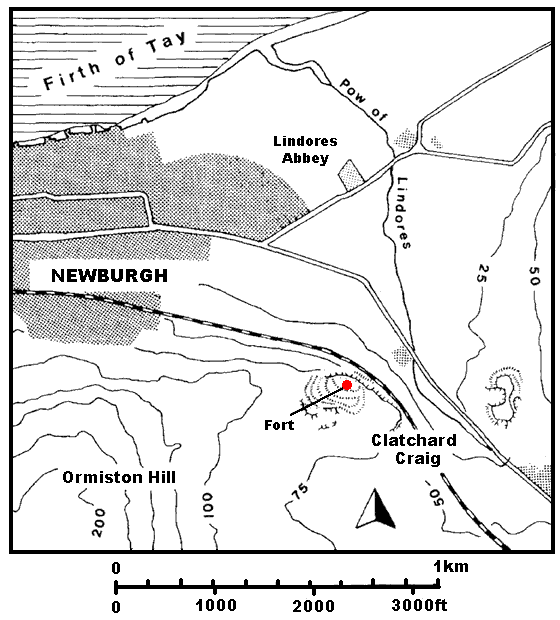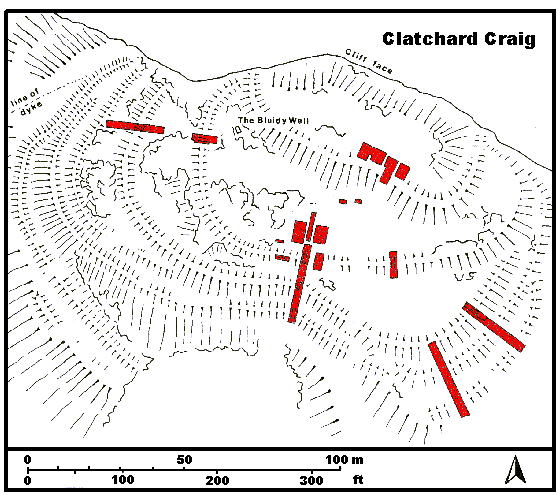

 |
|
Led by Claudius, the Romans invaded Briton in 43 AD. Between the years 80 AD and 85 AD,
Governor Agricola attempted to garrison Scotland and to bring it under Roman control.
Agricola was recalled to Rome by Domitian and the fort building ceased. Over the next
three centuries Roman presence was slowly withdrawn and their structures abandoned.
Several ancient sites on and around Ormiston Hill have been excavated by trained archeologists. Some are still available for public viewing. Sadly, too many are gone -- victims of stone quarrying operations and cannibalization of materials for modern construction projects. A number of Roman hillforts are strung out along the steeper northern edge of area ridges. One of these was Clatchard Craig, situated on a prominent hill which rose to 390 ft (119 m) above the town of Newburgh on the narrow coastal plain, about 1 km from the south shore of the Firth of Tay. The fort stood in the open mouth of a valley offering three good lines of communication from the coast through the hills back into the centre of Fife and on to the south, all three now utilized by roads and one also by the railway from Perth to Kirkcaldy. To the north the hill rose to a precipice some 60 m high, to the south-west it was joined by a low saddle to the higher summits of Ormiston Hill and Black Cairn Hill. There is a single rampart fort on the latter. Below the site a small burn, the Pow of Lindores, drains Lindores Loch into the Firth of Tay. At the base of the precipice runs the railway. To east and west of the fort the view was shut off by higher hills, and to the south by undulating country, but to the north it appears to have had an uninterrupted view some distance up and down the Firth. |
 |
|
Immediately across the burn another smaller hill, Mare's Craig, was destroyed by quarrying in the
1920s, when long cist burials and a small iron Celtic bell were found. Near this are the ruins of
Denmilne Castle, a late 16th-century tower house. Nearer the coast are the ruins of Lindores Abbey,
an important Tironensian house founded in the late 12th century.
Unfortunately the railway from Perth to Kirkcaldy became a threat to the site. Clatchard Craig, like the Mare's Craig, was formed of andesite, a hard stone which has largely been used as ballast for railways, though it is also used for roadstone and concrete aggregate. A quarry began to eat into the hill. Between the two World Wars the Ministry of Works made an application to the Ministry of Transport for the preservation of the fort on Clatchard Craig. This was unsuccessful, as the Ministry of Transport felt the stone was necessary for road construction. Quarrying operations in the vicinity proceeded, and the threat to the site grew ever more acute. Nothing could be done during the World War II, but in the 1950s, as the quarry reached the edge of the site, the Ministry of Works initiated excavation, first a short investigation by P R Ritchie in the winter of 1954-5, and then a more extensive campaign by R Hope-Simpson in 1959 and 1960. Between approximately 1950 and 1980 the fort was totally quarried away. |
|
(Ref.: Procedures of the Society of Scottish Antiquities, v.116 (1986), pp.117-184.) |

|
Return to ORMISTONS IN FIFE page |
